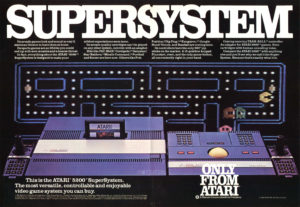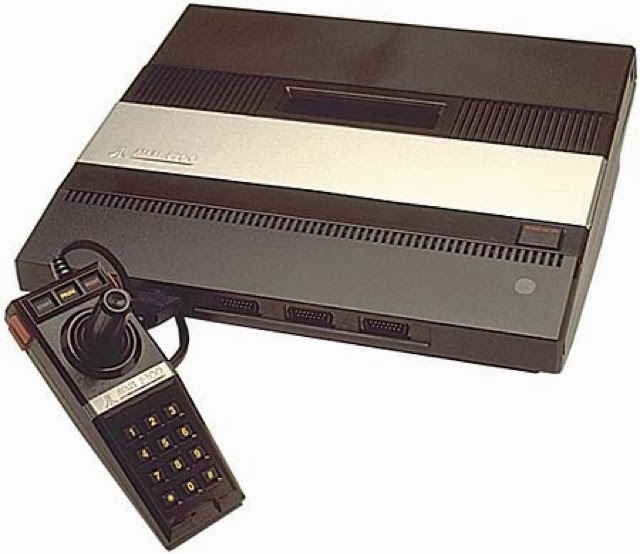You know the Atari 5200 gets knocked a lot by retro gamers. The Angry Video Game Nerd’s episode on it “Atari 5200” was pretty much remorseless towards the old system. I have to say that I loved my Atari 5200 and I know it may sound like sacrilege, but it was by all means a better system then the 2600. When I play Mario Brothers, or Berserk on my 2600 it’s somewhat disappointing compared to how great those same games looked and sounded on the 5200.
The 5200 did have its issues though one of which was its size which, to date still makes it one of the largest video came consoles ever made. Also its unusual coaxial/power device verged on being out and out one of the worst ideas ever. There’s also a lot of other complaints about the controllers themselves, with the lack of functionality, the weird side buttons, and the keypad at the bottom, all of which have come under fire at one time or another.
First of all let me say this, Atari both in the video game industry and in the business world in general, has come to be known for just making bad decisions. Now let me add this to that statement, Atari like Sega (as I talked about in part 2 last week) made bad business decisions which were bad for the time they where made, but later generations of video game consoles and their manufacturers would actual prosper from similar decisions. The Atari 5200 is the product of one of those types of decisions.

Come Christmas 1979 the Atari 2600 was still king of the hill in gaming systems, but it had attracted competitors. The Intellivison, and later Colecovision were coming into the picture and were cutting into Atari’s business with products that looked and performed better than the Atari 2600. Atari knew that if it was going to have any kind of future in the home gaming market it would need to find a way to compete. Three years later in November of 1982 Atari would release the Atari 5200.
The 5200 was a monster roughly 4 times bigger then an Atari 2600, and its cartridges where nearly twice the size of the Atari 2600’s. The system was roughly the size of a PC of the time excluding a monitor. Of course you have to consider that this would make sense since the Atari 5200 used technology based on that of Atari’s 400/800 8-bit computer systems. But part of its size also went into the controller storage area on the back of the console.
Overall game play was great though, and video gamers got their first taste of true 8-bit gaming, something that wouldn’t been seen again until the Nintendo NES three years later. For the most part titles found on the 5200 were ports of those on the 2600, but with the supped up graphics and sounds capabilities of the 8-bit 5200, games on the 5200 looked, felt, sounded, and played better then they did on the 2600. But, it was Atari’s intentions not to stop there with the 5200’s abilities, and using computing power like that of their 400/800 systems, Atari had hoped to give the 5200 some computer capabilities another reason why the keypad was necessary on the 5200’s controller. It can only be guessed that Atari had high hopes for their new system.
Sadly, though the odds were against the 5200, starting with its release date. By 1982 some indicators showed that the industry was in decline, and things would only get worse as 1983 dragged on. It would also be released nearly 3 months after the ColecoVision, making it late to the party in sales and popularity. Hoping to cash in on the success of the Atari 2600, the market had been flooded by clone consoles, and games. The old rules of economics with supply and demand kicked in and prices plummeted on just about anything video game related. In choosing between Atari’s new 5200, and the wide range of readily available and cheap Atari 2600 products and clones it was easy to figure out what direction consumers went in. The new 5200 never caught on and Atari took a loss on the new system, and year and a half later in May of 1984 the 5200 was discontinued by Atari, as the 7800 went into development. The goal of the Atari 7800 would be to introduce an updated and more advanced system that could take full advantage of the glut of Atari 2600 games on the market, by being backward compatible while delivering the full 8-bit graphics that generation 3 would be known for. This move would solidify the Atari 5200 as a mezzanine console of generation 2.5 as it found itself sandwiched in between generation 2 mainstay the Atari 2600, and generation 3 contender and NES competitor, the Atari 7800.
Atari much like Sega, who would have their trials a decade later, and was trying to deliver products and market strategies that were ahead of their time. From Gen 6 onward we would see consoles that could offer consumers not just a video game console, but more of an entertainment and multimedia platform, something solidified in Gen 7 by the XBOX 360 and PS3. In the 5200’s case we saw a system that was attempting to do something similar arriving in the house as a video game system, and later becoming the family computer or at least a simple version of one. Atari was trying to produce a great deal of value with the 5200 by giving consumers a little more bang for there buck. Also like Sega, Atari tried to offer products at various price points much as the Saturn was the premium system in Sega’s case, the 5200 was the premium system in Atari’s day, while the Atari 2600 took on a similar role of that of the Sega 32X later, but unlike Sega with the 32X, Atari had a popular product in the Atari 2600. Luckily for Atari the decision to price point products and compete against itself worked as sales of Atari 2600’s, even at a reduced price point still represented a profit, something taking the 2600 out of production when the 5200 was released wouldn’t have done..
When I look at the Atari 5200 I don’t see a bad system, and really it wasn’t. It had its flaws and if it had a longer lifespan those would have been worked out just as the coaxial/power device issue was worked out in late 1983 models. What I see is the first X.5 system, the first mezzanine system, a system trying to be the next generation but falling short this time because of economics, and greed within its industry.

